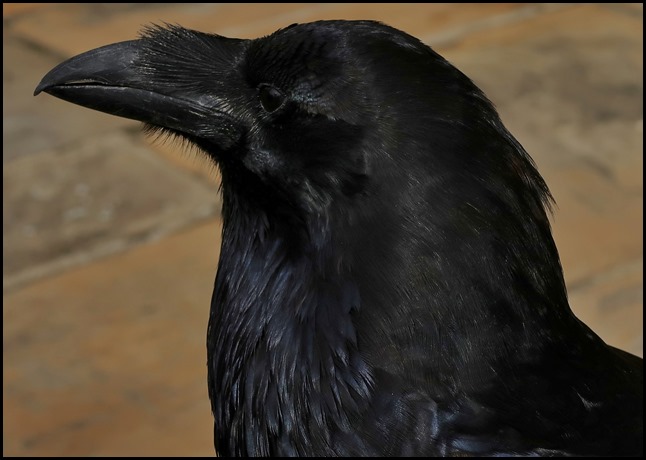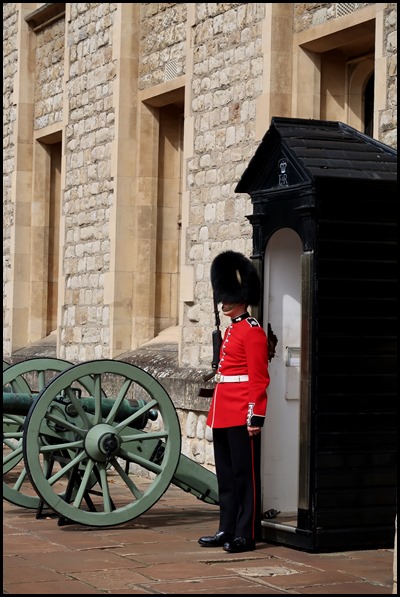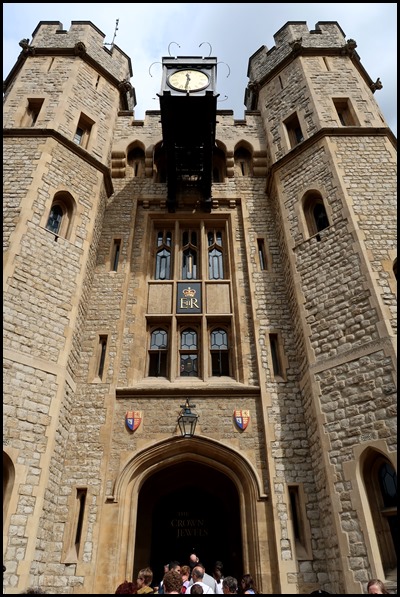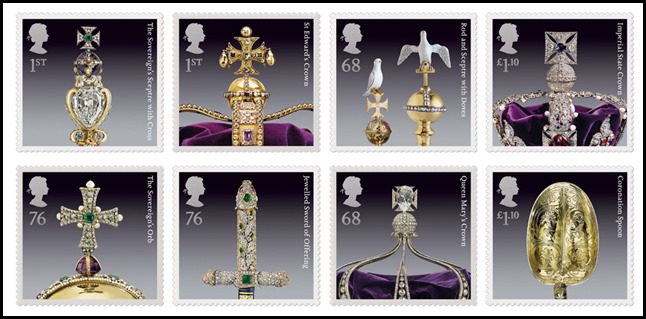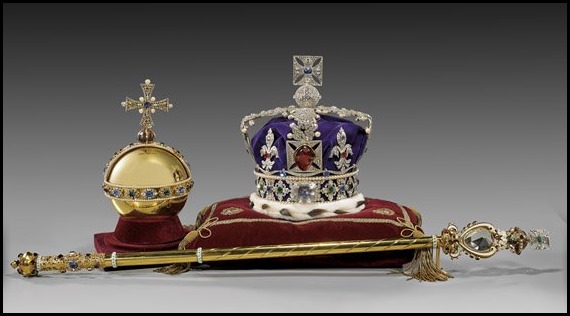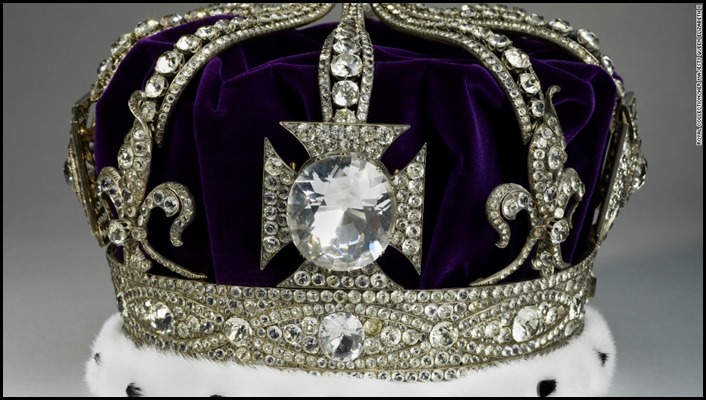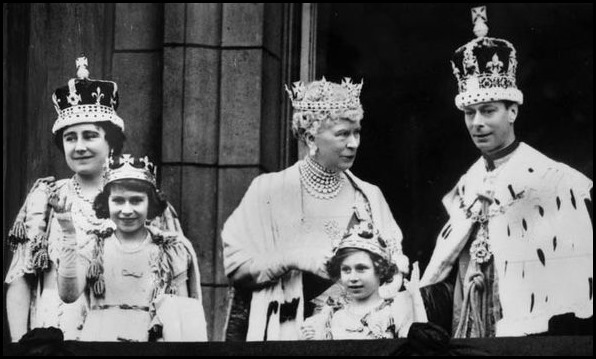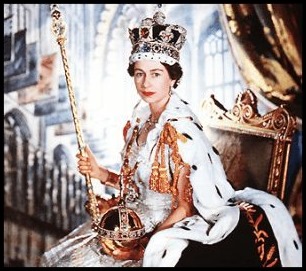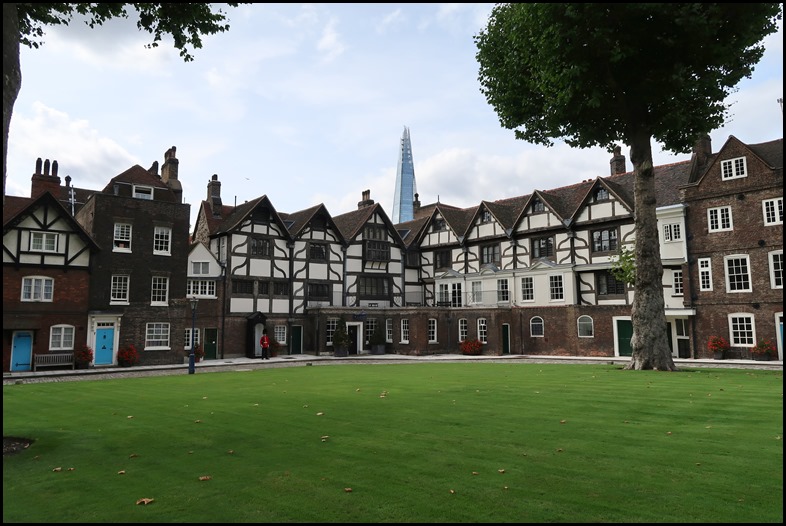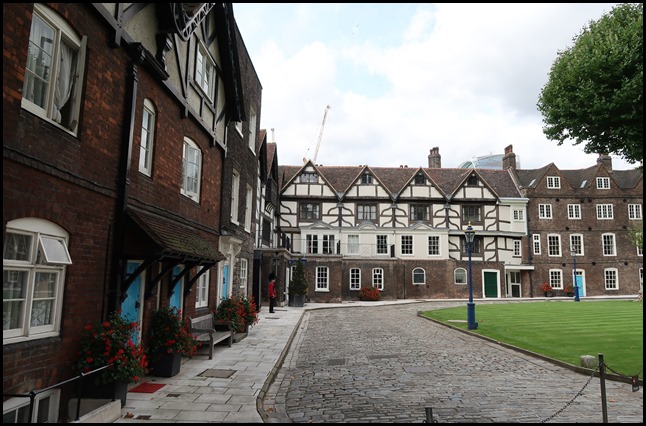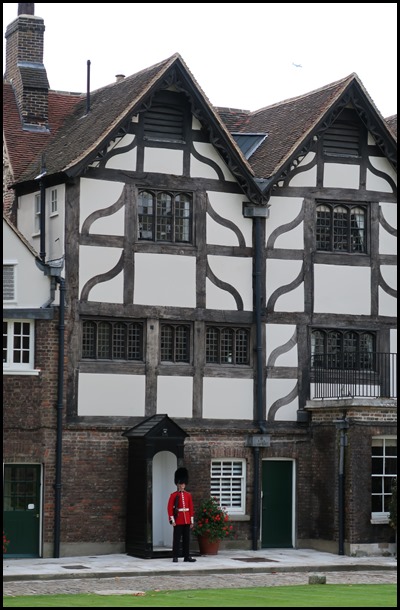To Crown Jewels

|
Tower of
London
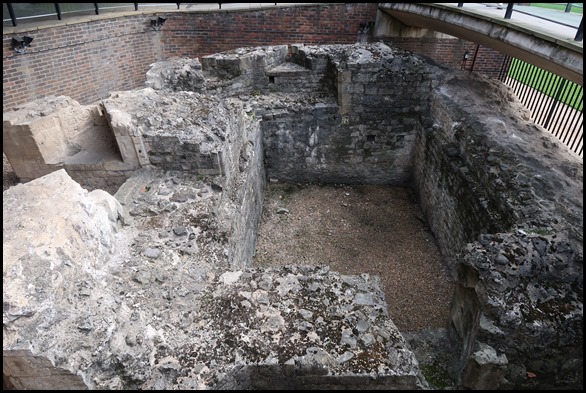 After a hearty breakfast, we made our
way to the Tower of London, for many years on our ‘wish list’. We had a short
walk from the Underground and as we came out into daylight after crossing under
the road, we saw these intriguing ruins. The plaque reads:
Tower of
London Medieval Postern. This medieval postern gate gave access to the
City of London from the east. It is the only known surviving example of a large
medieval gate tower in the city wall. The construction of the subway provided
the opportunity to excavate and conserve the remains.
Three arrow loops in the
multi-angular tower commanded the approach. The postern was also protected by
two wooden gates and a portcullis, the groove for which may still be
seen.
The fine quality of the masonry
suggests that the postern might have been built from the late 13th century
onwards, by the royal masons who were carrying out major modifications to the
Tower of London.
Just past the postern were more
information boards.
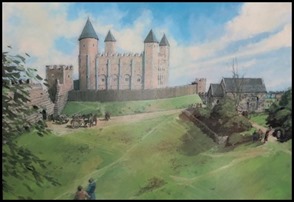 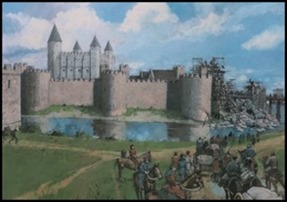  The Norman
Tower of London: Begun in 1075-9, William the Conqueror’s stone tower was
so impressive that the castle is still called the Tower today. He built a
fortress on the river in the south east of the ancient Roman city to control
Londoners and deter invaders.
His son, William Rufus, completed
the tower by 1100. His fortress and royal residence dominated the city and
demonstrated the Norman’s dynasty’s lordship over the land. The tower was
protected on two sides by the Roman wall. A new ditch, an earthwork and a timber
rampart were built to surround the north and west sides.
Collapse at
the Tower of London: Between 1238-40 Henry III expanded the castle beyond
the Roman city boundary, ringing it with a new wall and whitewashing the Norman
tower. He also built a magnificent western entrance which unfortunately
collapsed the following year.
Londoners thought that the king
was filling his castle with dungeons to imprison his enemies and they rejoiced
when the gate-tower fell, believing it to be a sign of divine retribution.
Today, Henry’s outer wall survives but there is no visible sign of his gateway.
The whitewashed Norman tower is still called the ‘White Tower’ although it has
not been painted since the 17th century.
The Tower in
Flames: In the early hours of the 31st of October 1841, the Grand
Storehouse caught fire and burned to the ground. Crowds watched the flames
destroy the huge 17th century building and artists painted the
spectacle.
The fire began in a gun workshop
and spread to the Grand Storehouse. It also destroyed part of Henry III’s
13th-century outer wall. The Grand Storehouse had been built in 1692 to store
and display weaponry. It replaced Henry VIII’s armoury storehouses and was in
turn replaced in 1842 by the massive Waterloo Barracks which you can see
today.
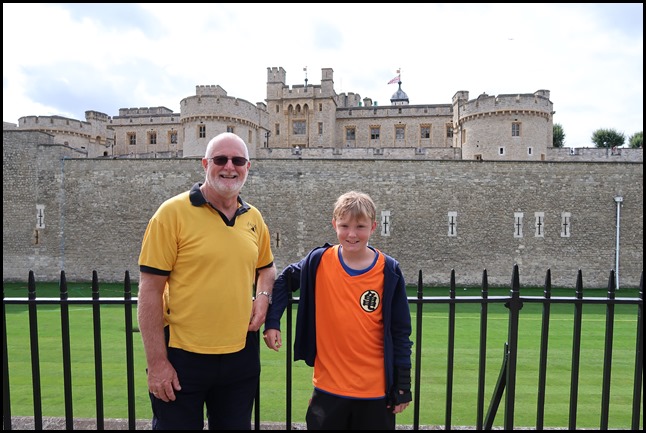 I got Bear and
Harley to stand in my first ever view of the Tower of
London.
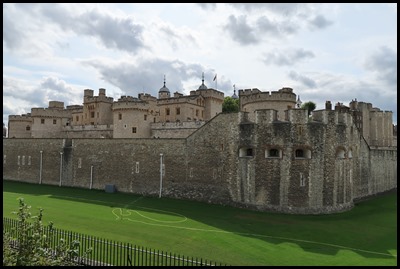 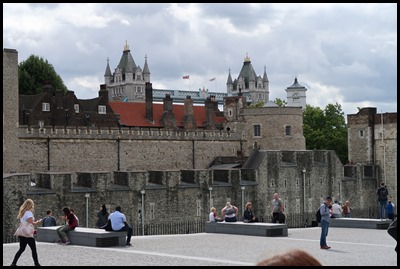 Walking toward the
corner of the Tower of London, heading for the ticket booths we looked up
at a skyline dominated by Tower Bridge.
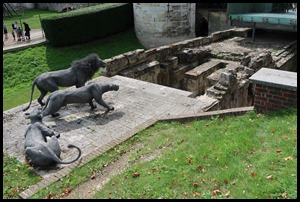 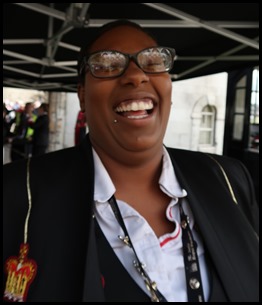 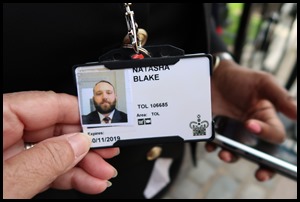 Passing a display of animals and more ruins we headed for the entrance. Having
London Passes meant we just had to show them to the lovely
lady who roared with laughter when I admired her
beard on her name tag.............
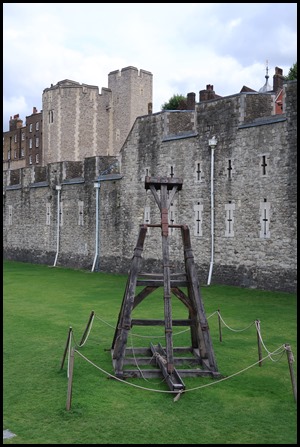 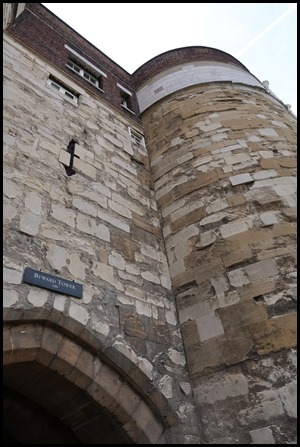 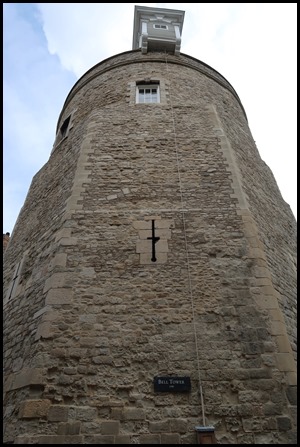 Passing a ‘rock
launcher’, in under Byward Tower (1280) and by
the Bell Tower (1190), we were at last
inside.
 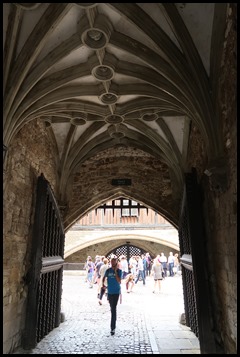  Well, just looking at the buildings
and architecture was a joy.
 A Beefeater told us that the queue was short and it would be a good time to see the Crown Jewels. Thrilled was I to see two ravens sitting on the fence. Many stories and much writing has been done about these canny birds but here is a snippet from good old Wiki:........ The Ravens of the Tower of London are a group of at least six captive ravens which live at the Tower of London. Their presence is traditionally believed to protect the Crown and the tower; a superstition holds that "if the Tower of London ravens are lost or fly away, the Crown will fall and Britain with it", certainly the story my mum told me as a youngster. The ravens cannot fly because the flight feathers on one wing are clipped. With a single wing clipped, they can only fly short distances to perch. Each Tower raven has a name and has a different coloured band on one leg, to make it easier to identify individual birds. Ravens in captivity in the Tower grounds have had lifespans of over 40 years. The Tower's ravens are given individual names, and are all under the care of the Yeomen Warders. The diet of the ravens is carefully maintained; it includes fresh fruit, cheese and fresh meat, as well as vitamins and other supplements. In 2007, the Ravenmaster Derek Coyle commented: "I buy fresh meat from Smithfield – liver, lamb, beef, chicken. And occasionally when I’m at my own place in Suffolk someone will give me some rabbit that’s been killed. If I see roadkill on the road, and it’s not been too badly mangled, I normally put it in a black bag and bring it back here. I give them biscuits as well, soaked in blood from the meat that I buy. And in winter I get them capsules of cod liver oil. I know they’re getting as much vitamins and oil as they possibly can. That’s why they look so healthy." He also says, "Every day they’ve all had at least 8 oz of meat. Every other day they’ll get a boiled egg and I’ll give them chopped apple, grapes – they love cheese by the way." There are lots of wonderful stories about the birds, here are just a few: Most Londoners are fond of the ravens, but sometimes an individual bird will fall out of favour because of inappropriate behaviour. For example, "Raven George" lost his appointment to the Crown, and was retired to Wales for attacking and destroying TV aerials. A special decree was issued about the incident: On Saturday 13th September 1986, Raven George, enlisted 1975, was posted to the Welsh Mountain Zoo. Conduct unsatisfactory, service therefore no longer required. In 1996, two more ravens fell out of favour and were dismissed from the Tower for "conduct unbecoming Tower residents."...........
I leaned in really close to get this handsome chaps face, a head-on shot, perfect. An American lady beside me began to do the same thing, he turned his head away from me at that second (darn) and she screamed thinking that he was stuffed............. As we followed the zig-zag fenced queue there were information plaques. In 1661 the Tower became the permanent home for the new Crown Jewels. Most of the objects that you will see today were made for Charles II’s coronation in 1661, and followed closely the form and symbolism of those that had been destroyed. People have been coming to see the Crown Jewels at the Tower ever since. In the 17th and 18th centuries some visitors were allowed to handle the Jewels – for an additional fee to the warder. 1815. Security stepped up after a visitor seizes the State Crown: A woman seized the State Crown and wrenched its arches apart. The crown was ‘very much damaged’ and had to be repaired at what was then a substantial cost of ten pounds and ten shillings, equivalent to a soldier’s wages for seven months. A magistrate found the woman ‘insane’ and security measures were increased – visitors were no longer allowed to handle the Crown Jewels after this. 2nd of June 1953: A gun is fired at the Tower to mark the coronation of Elizabeth II. In accordance with tradition, a 62-gun salute was fired from Tower Wharf at the moment that Queen Elizabeth II was crowned in Westminster Abbey. This salute is repeated each year on the anniversary of her coronation. Similar salutes mark her accession to the throne, actual birthday and official birthday.
A Sentry to our left and nearly to the door.
We walked through the main door of the Jewel Tower and through a foot-wide safe door and wow, a sparkly world was upon us. No photography is allowed (people of course tried) but there are plenty of images on the internet of the Crown Jewels. The main jewels can be viewed by standing one of the moving walkways that pass each side. I went on both sides twice to have a really good look and thought the various crowns were stunning. Oooo the sparkle. Then we looked at the gold salvers, altar plates, candlesticks and more shiny stuff.
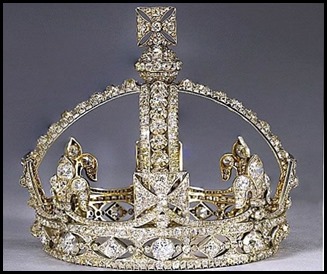 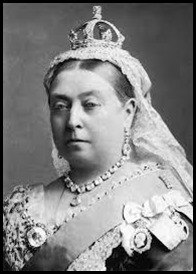 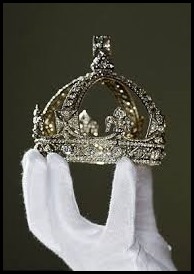
There was a display case holding Queen Victoria’s personal jewels, my favourite being the little crown. Queen Victoria’s miniature crown measures three and a half inches across by four inches high but contains an astonishing one thousand two hundred diamonds. Made by Garrard, it was designed to be worn over the veil Queen Victoria adopted following the death of her beloved husband, Prince Albert. Because of its physical lightness, she favoured it over any other in the last thirty years of her life. She wore it in both official portraits for her golden and diamond jubilees.
We head toward Bloody Tower but en route take in the beautiful Tower Green.
This area is used for ceremonies, such as the installation of the Constable. Here you are surrounded by the homes of Tower officials. The grand timber-framed building is the Queen’s House, built in 1540. This is where Guy Fawkes was questioned after trying to blow up the Houses of Parliament in 1605. Today, it’s the private home of the Resident Governor.
The name ‘Queen’s House’ dates from Queen Victoria’s reign (1837-1901), but changes to ‘King’s House’ when our reigning monarch is male. This building was previously the Lieutenant’s Lodgings and has been the site of the chief Tower official’s residence for centuries. Parts of a Constable’s lodgings from the 14th century are still visible inside. The Queen;s House is the finest timber-framed building to have survived the Great Fire of London in 1666.
Where we are - in the
circle.
A Sentry – so English, so
special.................... 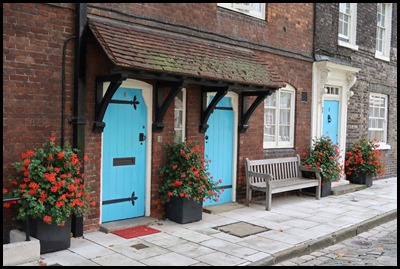 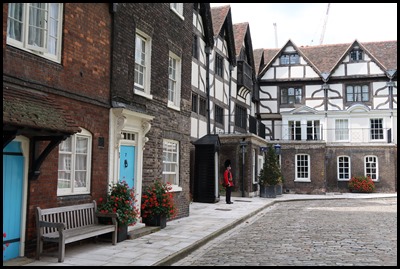 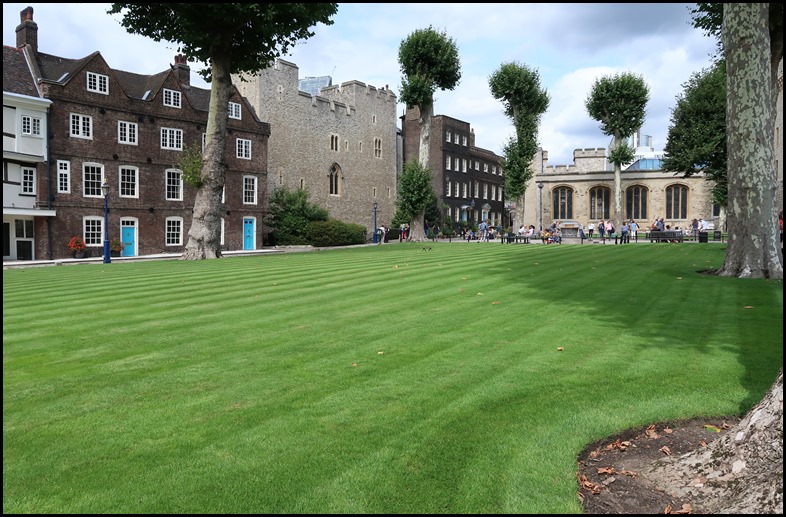 ALL IN ALL THRILLED TO HAVE SEEN
THE CROWN JEWELS
STUNNING |
